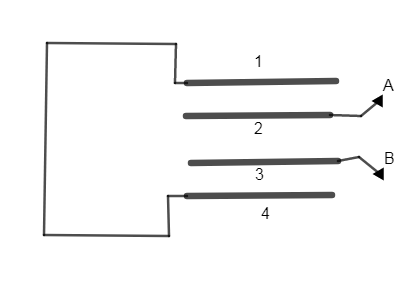
Answer
431.4k+ views
Hint: It is given in the question that the four metallic plates each with a surface area of A placed at a distance d from each other and we have to find the capacitance between point a and b to do so we have to simplify the given figure and check which the capacitor is parallel to the each other and which one is in series and by using formula of the capacitance we can get total capacitance of the given system.
Formula used:
$C=\dfrac{{{\varepsilon }_{o}}A}{d}$
Complete answer:
In order to find a solution we have to simplify the circuit by making all four plates by 1, 2, 3, and 4 as shown in the figure.

Now to further simplify the circuit we will write points step by step and then we will draw full circuit.
Now ‘a’ is connected with the plate 2 which is in connection with the plate 1 and the plate 3, therefore capacitor 21 and 23 will be in parallel connection.
Now plate 1 is connected to plate 4 which is making a capacitor with plate 3 therefore the capacitor 21 and 43 will be in the series connection.
Now the capacitor with the plate 23 and the plate 43 has common plate 3 which is connected to b.
Now let’s make the figure according to our simplification.

Now the total capacitance of the capacitor which are connected in series is,
Note that all have the same capacitance ‘c’ because their area and the distance are same.
$\begin{align}
& \dfrac{1}{{{C}_{1}}}=\dfrac{1}{C}+\dfrac{1}{C}\text{ }\left( \text{for the plate }\!\!'\!\!\text{ 21 }\!\!'\!\!\text{ and }\!\!'\!\!\text{ 43 }\!\!'\!\!\text{ } \right) \\
& \dfrac{1}{{{C}_{1}}}=\dfrac{2C}{{{C}^{2}}} \\
& \therefore {{C}_{1}}=\dfrac{C}{2}....\left( 1 \right) \\
\end{align}$
Now the total capacitance,
$\begin{align}
& {{C}_{T}}=C+\dfrac{C}{2} \\
& {{C}_{T}}=\dfrac{3C}{2}...\left( 2 \right) \\
\end{align}$
Now we know that formula for the capacitor is,
$C=\dfrac{{{\varepsilon }_{o}}A}{d}$
$C=\dfrac{{{\varepsilon }_{o}}A}{d}$
Where, ${{\varepsilon }_{o}}$ = permittivity
A = area
d = distance between the two conductive plate,
Now substitute value of the equation (3) in the equation (2)
$\begin{align}
& {{C}_{T}}=\dfrac{3}{2}\times \dfrac{{{\varepsilon }_{o}}A}{d} \\
& {{C}_{T}}=\dfrac{3{{\varepsilon }_{o}}A}{2d} \\
\end{align}$
Therefore the option (D) is correct.
Note:
While calculating capacitance of the parallel circuit and the series circuit be careful while putting the formulas of the series and parallel connection because sometimes we can be mistaken formulas as we are using formulas resistance formula i.e.
Series connection,
Resistance,
${{R}_{e}}={{R}_{1}}+{{R}_{2}}+{{R}_{3}}....$
Capacitor,
$\dfrac{1}{{{C}_{e}}}=\dfrac{1}{{{C}_{1}}}+\dfrac{1}{{{C}_{2}}}+\dfrac{1}{{{C}_{3}}}....$
Parallel connection,
Resistance,
$\dfrac{1}{{{R}_{e}}}=\dfrac{1}{{{R}_{1}}}+\dfrac{1}{{{R}_{2}}}+\dfrac{1}{{{R}_{3}}}......$
Capacitor,
${{C}_{e}}={{C}_{1}}+{{C}_{2}}+{{C}_{3}}.....$
Formula used:
$C=\dfrac{{{\varepsilon }_{o}}A}{d}$
Complete answer:
In order to find a solution we have to simplify the circuit by making all four plates by 1, 2, 3, and 4 as shown in the figure.

Now to further simplify the circuit we will write points step by step and then we will draw full circuit.
Now ‘a’ is connected with the plate 2 which is in connection with the plate 1 and the plate 3, therefore capacitor 21 and 23 will be in parallel connection.
Now plate 1 is connected to plate 4 which is making a capacitor with plate 3 therefore the capacitor 21 and 43 will be in the series connection.
Now the capacitor with the plate 23 and the plate 43 has common plate 3 which is connected to b.
Now let’s make the figure according to our simplification.

Now the total capacitance of the capacitor which are connected in series is,
Note that all have the same capacitance ‘c’ because their area and the distance are same.
$\begin{align}
& \dfrac{1}{{{C}_{1}}}=\dfrac{1}{C}+\dfrac{1}{C}\text{ }\left( \text{for the plate }\!\!'\!\!\text{ 21 }\!\!'\!\!\text{ and }\!\!'\!\!\text{ 43 }\!\!'\!\!\text{ } \right) \\
& \dfrac{1}{{{C}_{1}}}=\dfrac{2C}{{{C}^{2}}} \\
& \therefore {{C}_{1}}=\dfrac{C}{2}....\left( 1 \right) \\
\end{align}$
Now the total capacitance,
$\begin{align}
& {{C}_{T}}=C+\dfrac{C}{2} \\
& {{C}_{T}}=\dfrac{3C}{2}...\left( 2 \right) \\
\end{align}$
Now we know that formula for the capacitor is,
$C=\dfrac{{{\varepsilon }_{o}}A}{d}$
$C=\dfrac{{{\varepsilon }_{o}}A}{d}$
Where, ${{\varepsilon }_{o}}$ = permittivity
A = area
d = distance between the two conductive plate,
Now substitute value of the equation (3) in the equation (2)
$\begin{align}
& {{C}_{T}}=\dfrac{3}{2}\times \dfrac{{{\varepsilon }_{o}}A}{d} \\
& {{C}_{T}}=\dfrac{3{{\varepsilon }_{o}}A}{2d} \\
\end{align}$
Therefore the option (D) is correct.
Note:
While calculating capacitance of the parallel circuit and the series circuit be careful while putting the formulas of the series and parallel connection because sometimes we can be mistaken formulas as we are using formulas resistance formula i.e.
Series connection,
Resistance,
${{R}_{e}}={{R}_{1}}+{{R}_{2}}+{{R}_{3}}....$
Capacitor,
$\dfrac{1}{{{C}_{e}}}=\dfrac{1}{{{C}_{1}}}+\dfrac{1}{{{C}_{2}}}+\dfrac{1}{{{C}_{3}}}....$
Parallel connection,
Resistance,
$\dfrac{1}{{{R}_{e}}}=\dfrac{1}{{{R}_{1}}}+\dfrac{1}{{{R}_{2}}}+\dfrac{1}{{{R}_{3}}}......$
Capacitor,
${{C}_{e}}={{C}_{1}}+{{C}_{2}}+{{C}_{3}}.....$
Recently Updated Pages
Fill in the blanks with suitable prepositions Break class 10 english CBSE

Fill in the blanks with suitable articles Tribune is class 10 english CBSE

Rearrange the following words and phrases to form a class 10 english CBSE

Select the opposite of the given word Permit aGive class 10 english CBSE

Fill in the blank with the most appropriate option class 10 english CBSE

Some places have oneline notices Which option is a class 10 english CBSE

Trending doubts
Fill the blanks with the suitable prepositions 1 The class 9 english CBSE

How do you graph the function fx 4x class 9 maths CBSE

When was Karauli Praja Mandal established 11934 21936 class 10 social science CBSE

Which are the Top 10 Largest Countries of the World?

What is the definite integral of zero a constant b class 12 maths CBSE

Why is steel more elastic than rubber class 11 physics CBSE

Distinguish between the following Ferrous and nonferrous class 9 social science CBSE

The Equation xxx + 2 is Satisfied when x is Equal to Class 10 Maths

Differentiate between homogeneous and heterogeneous class 12 chemistry CBSE





